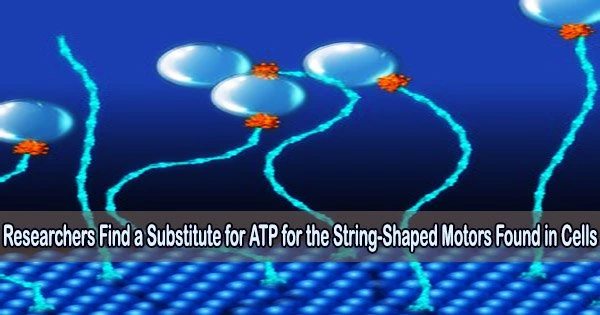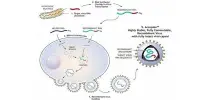Molecular motors, which are small protein engines that produce controlled movements, are a fascinating characteristic of cells that allow them to neatly arrange their internal space. Most of them run on ATP, a kind of molecular energy that is widely used as a fuel.
Now researchers from the Max Planck Institute of Molecular Cell Biology and Genetics (MPI-CBG), the Cluster of Excellence Physics of Life (PoL) and the Biotechnology Center (BIOTEC) of the TU Dresden in Dresden, Germany, and the National Centre for Biological Sciences (NCBS) in Bangalore, India, discovered a novel molecular system that uses an alternative chemical energy and employs a novel mechanism to perform mechanical work.
This molecular motor assists in distributing cargo to organelles that are linked to membranes by periodically contracting and expanding. It works similarly to a traditional Stirling engine. It is the first motor that uses two parts, two proteins of different sizes, Rab5 and EEA1, and is powered by GTP rather than ATP. The results are published in the journal Nature Physics.
A cell’s motor proteins are amazing molecules that transform chemical energy, which is housed in the molecule ATP, into mechanical work. Myosin, a protein that aids in muscle movement, is the most notable example. Small proteins called GTPases, in contrast, have not been thought of as molecular force generators.
One example is a molecular motor composed of two proteins, EEA1 and Rab5. In 2016, an interdisciplinary team of cell biologists and biophysicists in the groups of MPI-CBG directors Marino Zerial and Stephan Grill and their colleagues, including PoL and BIOTEC research group leader Marcus Jahnel, discovered that the small GTPase protein Rab5 could trigger a contraction in EEA1.
Our results show that the proteins EEA1 and Rab5 work together as a two-component molecular motor system that can transfer chemical energy into mechanical work. As a result, they can play active mechanical roles in membrane trafficking. It is possible that the force-generating molecular motor mechanism may be conserved across other molecules and used by several other cellular compartments.
Marino Zerial
These tether proteins in the form of strings can bind to the Rab5 protein found in vesicle membranes. Similar to how cooking softens spaghetti, the binding of the much smaller Rab5 transmits a signal throughout the EEA1’s elongated structure, increasing its flexibility. As a result of this flexibility shift, a force pulls the vesicle in the direction of the target membrane, where docking and fusion take place.
The team also proposed that EEA1 might flip between a flexible and a rigid state by only interacting with Rab5, which would function like a mechanical motor motion.
This is where the current study begins, which was inspired by the PhD work of the study’s two initial authors. Joan Antoni Soler from Marino Zerial’s research group at MPI-CBG and Anupam Singh from the group of Shashi Thutupalli, a biophysicist at the Simons Centre for the Study of Living Machines at the NCBS in Bangalore, set out to experimentally observe this motor in action.
With an experimental design to investigate the dynamics of the EEA1 protein in mind, Anupam Singh spent three months at the MPI-CBG in 2019.
“When I met Joan, I explained to him the idea of measuring the protein dynamics of EEA1. But these experiments required specific modifications to the protein that allowed measurement of its flexibility based on its structural changes,” says Anupam. Joan Antoni Soler’s expertise in protein biochemistry was a perfect fit for this challenging task.
“I was delighted to learn that the approach to characterize the EEA1 protein could answer whether EEA1 and Rab5 form a two-component motor, as previously suspected. I realized that the difficulties in obtaining the correct molecules could be solved by modifying the EEA1 protein to allow fluorophores to attach to specific protein regions. This modification would make it easier to characterize the protein structure and the changes that can occur when it interacts with Rab5,” explains Joan Antoni.
Armed with the suitable protein molecules and the valuable support of co-author Janelle Lauer, a senior postdoctoral researcher in Marino Zerial’s research group, Joan and Anupam were able characterize the dynamics of EEA1 thoroughly using the advanced laser scanning microscopes provided by the light microscopy facilities at the MPI-CBG and the NCBS.
Surprisingly, they found that only the chemical energy supplied by the EEA1 protein’s interaction with the GTPase Rab5 could cause it to go through numerous cycles of flexibility transition, going from rigid to flexible and back again. These experiments showed that EEA1 and Rab5 form a GTP-driven two-component motor.
Marcus Jahnel, one of the corresponding authors and head of the research group at PoL and BIOTEC, created a brand-new physical model to explain the interaction between chemical and mechanical phases in the motor cycle in order to interpret the findings.
The biophysicists were also able to determine the thermodynamic efficiency of the new motor system, which is comparable to that of traditional ATP-driven motor proteins. This was done in collaboration with Stephan Grill and Shashi Thutupalli.
“Our results show that the proteins EEA1 and Rab5 work together as a two-component molecular motor system that can transfer chemical energy into mechanical work. As a result, they can play active mechanical roles in membrane trafficking. It is possible that the force-generating molecular motor mechanism may be conserved across other molecules and used by several other cellular compartments,” Marino Zerial summarizes the study.
Marcus Jahnel adds, “I am delighted that we could finally test the idea of an EEA1-Rab5 motor. It’s great to see it confirmed by these new experiments. Most molecular motors use a common type of cellular fuel called ATP. Small GTPases consume another type of fuel, GTP, and have been thought of mainly as signaling molecules. That they can also drive a molecular system to generate forces and move things around puts these abundant molecules in an interesting new light.”
Stephan Grill is equally excited: “It’s a new class of molecular motors! This one doesn’t move around like the kinesin motor that transports cargo along microtubules but performs work while staying in place. It’s a bit like the tentacles of an octopus.”
“The model we used is inspired by that of the classical Stirling engine cycle. While the traditional Stirling engine generates mechanical work by expanding and compressing gas, the two-component motor described uses proteins as the working substrate, with protein flexibility changes resulting in force generation. As a result, this type of mechanism opens up new possibilities for the development of synthetic protein engines,” adds Shashi Thutupalli.
Overall, the authors are hopeful that the results of this new multidisciplinary study will pave the way for future work in both molecular cell biology and biophysics.
















